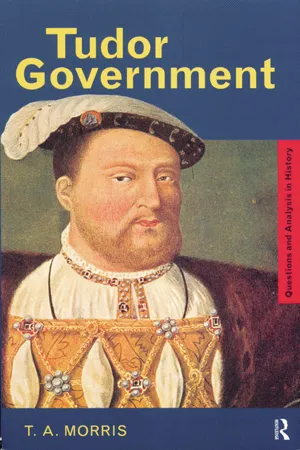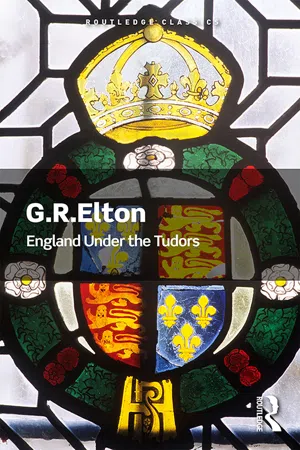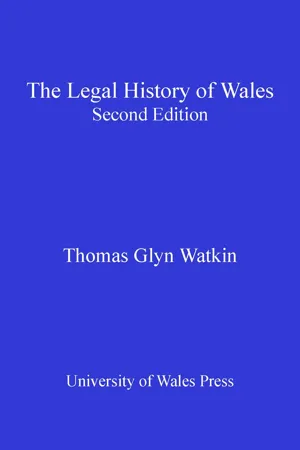History
The Tudors
The Tudors were a royal dynasty that ruled England from 1485 to 1603, known for their significant impact on English history. The most famous Tudor monarchs include Henry VIII, who famously had six wives, and his daughter Elizabeth I, who presided over a period of cultural and political flourishing known as the Elizabethan era. The Tudor period also saw the English Reformation and the expansion of English power.
Written by Perlego with AI-assistance
Related key terms
4 Key excerpts on "The Tudors"
- eBook - ePub
- W M Ormrod(Author)
- 2011(Publication Date)
- The History Press(Publisher)
- 6 -
The House of Tudor 1485-1603
Richard Rex
T he argument that The Tudors brought peace, stability and prosperity to England after a century of infighting and disorder is a myth very largely of their own making: Henry VII, Henry VIII and Elizabeth I were all expert in the arts of what today is called propaganda, and much of the popular modern image of those rulers still derives from the messages they chose to impart to their subjects. To an extent, The Tudors were simply the beneficiaries of an economic and cultural dispensation that gave England new wealth, new ideas, and a new sense of its own identity during the sixteenth century. On the other hand, the greatest of The Tudors, Henry VIII and Elizabeth I, clearly helped to shape the government, religion and culture of their realm in a forceful, dynamic and expansive manner that demonstrated not only the long stretch of the arm of State but the real and considerable impact of personal monarchy. Most remarkably – and something often taken too much for granted today – the Tudor dynasty was the first successfully to establish both the principle and the practice of female monarchy: and if the experiment manifestly failed in the case of Jane Grey, and was at best of arguable success in the case of Mary I, it was spectacularly vindicated by the exceptionally durable and stable reign of Elizabeth I. Without the right of female succession, the Tudor dynasty would have failed in 1553, and might have gone down in history more in terms of the Lancastrian regime which, to a degree, it had earlier claimed to reinstate. The triumph of pragmatism represented in the failure of the male succession and the acceptance of regnant queens in itself articulated something of the new political culture that The Tudors had embraced and imposed upon the kingdom of England.HENRY VII (1485-1509)
Henry VII was born at some distance from the English throne. His mother, Margaret Beaufort, was the great-granddaughter of John of Gaunt by his mistress, Katherine Swynford, and it was from her that Henry derived the dregs of Plantagenet blood that were his claim to the succession in 1485. His father, Edmund Tudor, was connected less directly but more respectably with royalty. He was the son of a Welsh gentleman, Owen Tudor, a minor officeholder in the Lancastrian court who won the hand in marriage of none other than Catherine of Valois, the young widow of Henry V. Henry VII made more of this connection than he did of his dubious descent from John of Gaunt: Henry V was still a charismatic enough figure to be worth invoking, even if only as a relative by marriage. The irony is that, were it not for the French Salic Law (which, though not recognized by the English, forbade female succession), Henry VII had a better claim to the French crown than to the English. - eBook - ePub
- T.A. Morris(Author)
- 2005(Publication Date)
- Routledge(Publisher)
IN TUDOR MONARCHYBACKGROUND NARRATIVE
England, like most of Western Europe, was ruled by a monarchy and had been for some six centuries before The Tudors occupied the throne. In that time a range of principles had been developed to justify and to support royal government. Like their continental counterparts, English kings claimed that they ruled by divine right, by the will of God, and that they were therefore the guarantors of the stability and order that God desired on earth. In pre-Reformation Europe, such a claim facilitated a fruitful working partnership with the Church. Rebellion against the monarch was generally equated with rebellion against God and, if the rebels were defeated, they could expect to suffer horrible punishments that reflected the appalling nature of the crime of treason. If they won, and both Henry VII and Mary came to the throne essentially as successful rebels, then their triumph was represented as illustrating the divine will. The English crown passed from one generation to another by the principle of primogeniture, the right of the eldest surviving son to succeed the father. English monarchs, like others across Europe, went to considerable lengths to avoid the succession of a woman, generally considered to be incapable of exercising the coercive functions that lay at the heart of monarchy. While they did not follow France in instituting a Salic Law, which formally forbade the succession of a female, they much preferred the succession of a younger prince to that of an older princess. Thus, in 1547, the nine-year-old Edward VI succeeded his father, despite the fact that he had two half-sisters older than him. If fate forced a female ruler upon them, most people assumed that, like Mary Tudor, she would marry a strong husband, who would be capable of controlling the realm for her.At the beginning of the Tudor era the king was still in large part a warlord. It remained his primary duty to conduct the defence of the realm, to resist encroachments upon the territories and rights of his dynasty, and to combat domestic disorder. It remained true in the reigns of the first two Tudors that the king was expected to carry out such duties in person, at the head of his armies, and it required extensive rethinking to accommodate monarchs who, on account of their youth or their gender, could not fulfil these expectations. The monarch was also the protector and enforcer of the laws of the kingdom. The crown held a highly privileged position within the legal structure of the realm, but was expected to act within that structure. The powers of the Tudor monarchs were extensive, yet clearly limited. A range of political and economic functions was exclusively reserved for the monarch and none other: these constituted the royal ‘prerogative’. The monarch alone could declare war and conclude peace, arrange the marriages of members of the royal family, pardon offenders, summon and dissolve Parliament, or manage the coinage. In other respects the monarch was bound by the law. Even so strong-willed a ruler as Henry VIII felt the need to give legal basis to his break from Rome, and despite her strong conviction that her father’s actions had been contrary to the will of God, Queen Mary could not reverse them without due process of statute law. - eBook - ePub
- G.R. Elton(Author)
- 2018(Publication Date)
- Routledge(Publisher)
VIIIThe Crisis Of The Tudors, 1540–58
1. The Last Years of Henry VIIIThomas Cromwell’s fall marked something of a period in Tudor history. By depriving himself of his outstanding servant, Henry VIII destroyed the efficiency and the purpose of his government. For eighteen years—first under an ailing old man, then under a child, and finally under a woman—Tudor rule was tested to the utmost. That it survived at all was a tribute to the work of Henry VII, to the depth of king-worship and obedience to established authority which Henry VIII’s terrifying personality had riveted upon an England anxious to avoid disorder, and also to the administrative reforms of Thomas Cromwell which up to a point made continued government possible even when the crown failed to play its part. But while Tudor rule survived, to be resuscitated by Elizabeth and her more than competent ministers, it underwent such vicissitudes in those years—was so rarely animated by a steady or intelligent purpose—that the total achievement would fill barely a page. The years served a purpose: passions played themselves out in the clashing of extremes which, having had their turn, retained the less strength to trouble the government of Elizabeth; but such an argument savours of the ancient heresy that all things work to the best of all possible ends and that success crowns the work. It also under-estimates the degree to which the free play of passions, mostly religious, under Edward VI and Mary encouraged the growth of divisions which beset England in the second half of the century. It is impossible to say what would have happened but for the relaxation of good government between 1540 and 1558. The keynote of those eighteen years of somewhat purposeless turmoil is found in the development of the doctrinal changes which Henry VIII’s constitutional revolution had set in motion despite his will. It is a story of the conflict of two extremes in religion alternately getting the upper hand, with a complicating admixture of international troubles and diversified by a gigantic economic crisis. This last deserves, and shall have, a chapter to itself. - eBook - ePub
- Thomas Watkin(Author)
- 2012(Publication Date)
- University of Wales Press(Publisher)
7The Tudors and the Union with England
THE UNION OF WALES AND ENGLAND
The union of Wales and England was effected by two statutes passed during the reign of Henry VIII. These were the Act for Law and Justice to be Ministered in Wales in like Form as it is in this Realm of 1535/6 and the Act for Certain Ordinances in the King’s Dominion and Principality of Wales of 1542/3. They are frequently referred to as the Acts of Union.The 1530s was a decade which saw revolutionary change in the government of England and of English society, the most obvious features of which were the changes in religion which saw the jurisdiction of the Pope ended in England and replaced with that of the king in matters sacred as well as secular. The dissolution of the monasteries followed. Henry VIII and his advisers saw the kingdom, as the statutes state, as an empire1 with the king as the sovereign ruler. No part of the realm could therefore be beyond his jurisdiction, be it an institutional part, such as the Church, or a peripheral territory, such as Wales. The Acts of Union accomplished the necessary incorporation of Wales into the Tudor empire.On the eve of the union, the king’s attorney, Thomas Holte, painted a gloomy picture of the condition of Wales. Juries there he found corrupt; the giving of livery to followers and supporters and their subsequent maintenance was practised to the detriment of good order and sound justice; the forced exactions called cymortha were still being taken, and the stealing of cattle was rife. Holte’s proposed solution was to impose English law upon Wales, to abolish the partible inheritance of land and replace it with the English principle of primo geniture, and to ensure that in future homicides would no longer be settled by the payment of a fine, but if fines were paid they should go to the king, thus effectively ending the regalian right of Marcher lords to assist in or even insist upon the compounding of liability for killing in a financially favourable way. The land of Wales should be divided into shires, and justices of the peace should be appointed in them, officers who had been used very successfully to maintain order in England since the mid-fourteenth century.2
Learn about this page
Index pages curate the most relevant extracts from our library of academic textbooks. They’ve been created using an in-house natural language model (NLM), each adding context and meaning to key research topics.



